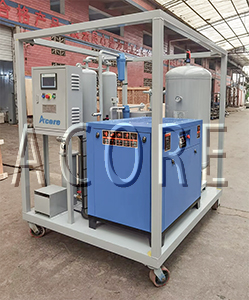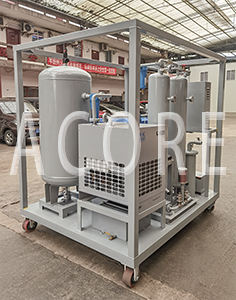DHP Air Dry Machine designed and manufactured by Acore Filtration Co.,Ltd sales to Canada, which mainly supply dry air when installing and maintaining the transformers, reactors and other large-scale power equipment. The dew point of dry air can reach -70°C. The Dry Air Generator can replace the traditional hot oil circulation, nitrogen supplementation, vacuum and other drying methods, and is more efficient, economical, safe and environmentally friendly.
The dry air machine device is mainly composed of four parts: air compressor, freeze drying system, adsorption drying system and electrical control system. The air enters the air storage tank through the air compressor, and most of the water is compressed and liquefied and discharged through the drain valve, and the air is sub-dried; After entering the refrigeration dryer, the water vapor is condensed into water, and the air is dried for the second time; Then enter the adsorption dryer for the third drying, adsorb the remaining trace water, and transport it to the equipment that needs to dry the gas through a high-precision air filter.
The dry air generator has the advantages of stable output pressure, low noise and strong purification ability, and is an ideal air source to replace high-pressure air cylinders. The product can not only meet the use of various types of domestic and imported gas chromatographs and various analytical laboratories, but also can be used as an air source for high-purity nitrogen generators. The Air Dry Machine is powered by a fully enclosed compressor, which purifies the natural air through three stages to remove water, oil and impurities in the air, and outputs stable and clean air through the pressure stabilizing device.




